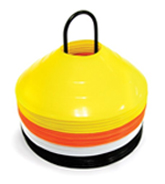Quick Tip to Improve Dribbling Skills, Reduce Turnovers, and Better Simulate Games
However I eventually became frustrated that players would execute the drills in practice great -- but when GAME TIME came, they struggled to dribble at high speed in fast break situations and against full court pressure.
I soon discovered my dribbling drills were missing a key ingredient to simulate game situations.
In games, a player needs to dribble the ball with their strong or weak hand at high speeds, while 5 other defenders are flying around, and 4 offensive players are moving getting open for a pass. Games are more chaotic and dynamic than typical dribbling drills. This "chaos" makes it difficult to simply dribble the ball down the court (especially with your weak hand at high speeds). I have found that very few high school players can do this well.
So here's what I did and it seemed to help tremendously...
I learned this trick from youth soccer coaches. They would have all the players dribble the ball at the same time going through patterns that forced them to run into each other. It looked very chaotic but it worked really well because it forced all the players to dribble with their head up.
So now I run dribbling drills where players have to deal with traffic, pressure, and various things coming at them. I always like to have as many players with a ball as possible (and preferably dribbling with two balls) because this is a much more efficient use of time. So I had to get a little creative. I usually use the same old drills as before and then I add "chaos" by forcing all players to run the drills at the same time (running at each other).
Here are a few twists that I added to some traditional drills (it really did the trick):
Chair Dribbling with Traffic
Zig Zag Cone Dribbling with Traffic
These are just a few examples of how I simulated game like situations. I'm sure you can come up with more.
I found that adding these dynamic aspects and "chaos" to the drill helps tremendously.
What do you think? What are your experiences? Do you have any thoughts, ideas, and suggestions?
Recommended Training Material:

|
SKLZ Agility Cones - 20 2" cones You can use the SKLZ cones for ballhandling drills, agility drills, shooting drills, defining boundaries for drills, creating grids, and much more. Agility cones features: Multiple high- visibility colors for marking training areas, Durable, will not break when stepped on. Includes: 20 cones – 5 each: yellow, black, white & orange, Carry rack for easy transport and storage...(more info) |
|
||||||||||||||||||||||||



 Facebook (145k Followers)
Facebook (145k Followers) YouTube (152k Subscribers)
YouTube (152k Subscribers) Twitter (33k Followers)
Twitter (33k Followers) Q&A Forum
Q&A Forum Podcasts
Podcasts